Best Beef Jerky Temperature
You’re about to discover the secret to achieving the most delicious and flavorful beef jerky every single time. In this article, we’ll unveil the best beef jerky temperature that will guarantee mouthwatering results. Whether you’re an experienced jerky enthusiast or a complete novice, understanding this crucial element will take your jerky game to a whole new level. Get ready to elevate your snacking experience with the perfect temperature for the juiciest, most tender, and irresistibly tasty beef jerky imaginable.
The Importance of Temperature in Beef Jerky Making
Beef jerky making is a delicate process that requires careful attention to various factors, with temperature being one of the most crucial ones. The temperature at which you prepare and dry your beef jerky plays a significant role in determining its flavor, texture, and overall safety. In this article, we will explore the importance of temperature in beef jerky making and provide you with valuable insights on how to achieve the perfect balance of flavors and textures while ensuring food safety.
Best Beef Jerky Temperature
Don’t burn your jerky like this, it is such a waste of what could have been extremely tasty jerky. Invest in a great Electric Smoker.
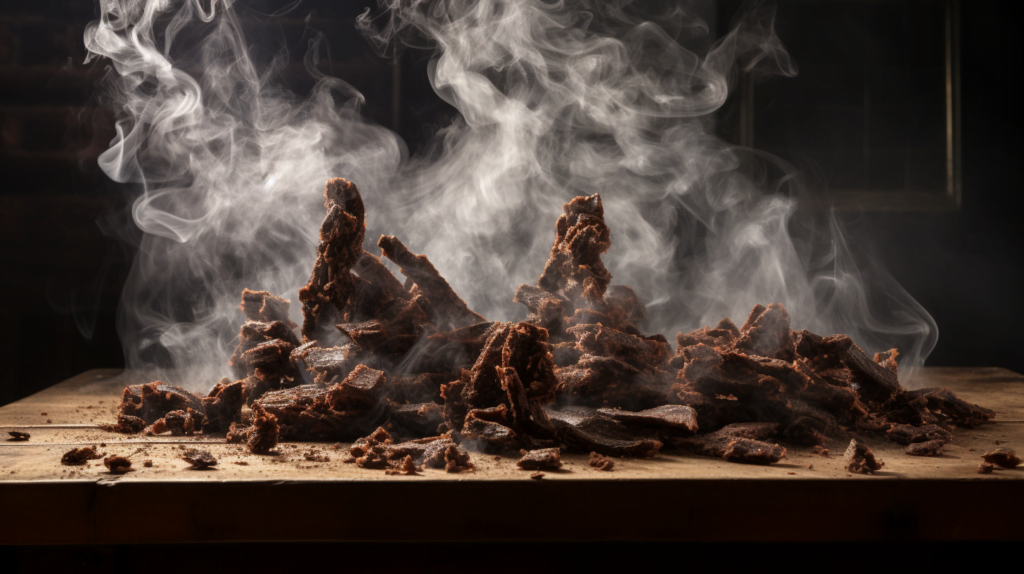
1.1 Understanding the Role of Temperature
Temperature is a key factor in the beef jerky making process as it directly influences the preservation, flavor development, and texture of the resulting product. By controlling the temperature, you can effectively inhibit the growth of bacteria, reduce moisture content, and enhance the development of desirable flavors and textures in your beef jerky.
1.2 Temperature Control and Food Safety
Proper temperature control is crucial in ensuring the safety of your homemade beef jerky. Bacteria, such as Salmonella and E. coli, thrive in warm and moist environments, making it essential to maintain temperatures that are unfavorable for their growth. By dehydrating the meat at the right temperature, you can significantly reduce the risk of foodborne illnesses caused by bacterial contamination.
1.3 Impact of Temperature on Flavor and Texture
Temperature plays a vital role in the development of flavors and textures in beef jerky. Lower temperatures allow for a slow and gradual removal of moisture, resulting in a tender and chewy texture. On the other hand, higher temperatures can lead to a more crispy and firm texture. Likewise, the temperature at which you marinate and dry your beef jerky can greatly influence the intensity and complexity of its flavors. Finding the ideal temperature range is crucial to achieving the desired flavor and texture profile for your beef jerky.
2. Best Beef Jerky Temperature The Ideal Temperature Range for Beef Jerky
Finding the ideal temperature range for beef jerky can be a challenging task as it depends on various factors. These factors include the type of meat, the thickness of the slices, humidity levels, and personal preferences. While there is no one-size-fits-all answer, experts have provided recommendations based on their extensive experience and experimentation.
2.1 Factors Influencing the Ideal Temperature
The ideal temperature for beef jerky preparation can vary depending on several factors. One crucial factor is the type of meat you’re using. Different cuts of meat may require different temperature ranges to achieve the desired texture and flavor. Additionally, the thickness of your meat slices can influence the drying time and the ideal temperature range. Thicker slices may need lower temperatures to ensure thorough dehydration without overcooking.
2.2 Recommendations by Experts
Experts in the field of beef jerky making generally recommend a temperature range of 130°F to 160°F (54°C to 71°C) for drying beef jerky. This temperature range ensures that the meat is cooked to a safe internal temperature while allowing for effective moisture removal. However, it’s important to note that these recommendations may vary based on individual preferences and specific recipes.
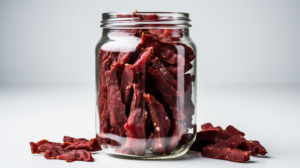
2.3 Experimentation with Temperature Levels
As with any culinary endeavor, experimentation is key to finding the perfect temperature range for your beef jerky. Start with the recommended temperature range and adjust accordingly based on your desired texture and flavor. Keep notes of the temperature and drying time used for each batch of beef jerky to help you fine-tune your process and achieve consistent results. Through trial and error, you’ll be able to develop your own unique technique and preferred temperature range.
3. Best Beef Jerky Temperature Preparing the Meat for Jerky Making
Now that we understand the significance of temperature in beef jerky making, let’s dive into the essential steps for preparing the meat before the drying process begins. Properly selecting, trimming, and marinating the meat are essential to achieving a quality beef jerky.
3.1 Choosing the Right Cuts of Meat
When it comes to making beef jerky, not all cuts of meat are created equal. It’s important to choose lean cuts of meat as excessive fat can hinder the drying process and contribute to spoilage. Popular choices for beef jerky include eye of round, top round, and bottom round. These cuts are traditionally low in fat and have a tight grain, making them ideal for achieving a tender and chewy texture in your beef jerky.
3.2 Trimming and Slicing Techniques
Before slicing your chosen cut of meat, it’s essential to trim off any excess fat, sinew, and connective tissue. Fat and moisture can impede the preservation process and contribute to spoilage. After trimming, slice the meat against the grain into thin, uniform strips. Slicing against the grain ensures a more tender final product as it shortens the muscle fibers.
3.3 Pre-Marination and Brining
Marinating the meat before drying is a step that should not be overlooked. It not only enhances the flavor of your beef jerky but also aids in the tenderization process. A marinade typically consists of a combination of acidic ingredients, such as vinegar or citrus juice, along with seasonings of your choice. Allow the meat to marinate in the refrigerator for a few hours or overnight to allow the flavors to penetrate the meat thoroughly.
4. Best Beef Jerky Temperature The Initial Temperature for Drying Beef Jerky
Once you have prepared your meat for jerky making, it’s time to consider the initial temperature at which you will begin the drying process. The initial temperature sets the stage for the subsequent drying period and plays a significant role in ensuring optimal flavor and texture in your beef jerky.
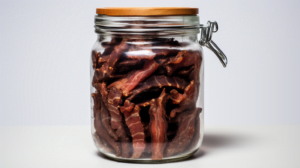
4.1 The Purpose of Starting at a Higher Temperature
Starting the drying process at a higher temperature serves two primary purposes. First, it helps to quickly kill off any potential bacteria on the surface of the meat, reducing the risk of contamination. Secondly, a higher initial temperature helps to seal in the natural juices and flavor of the meat, resulting in a more succulent and flavorful jerky.
4.2 Recommended Initial Temperature Levels
Experts typically recommend starting the drying process at a temperature between 160°F to 165°F (71°C to 74°C) for the first hour. This initial burst of heat contributes to the safety and quality of your beef jerky. However, it’s important to note that temperatures above 165°F (74°C) should be avoided as they may cause the meat to overcook and become tough.
4.3 Avoiding Overcooking or Burnt Jerky
While a higher initial temperature is beneficial, it’s crucial to monitor the drying process closely to avoid overcooking or burning your beef jerky. As the drying progresses, it’s recommended to reduce the temperature to the optimal range of 130°F to 160°F (54°C to 71°C) and continue the drying process until the desired level of moisture removal is achieved.
5. Best Beef Jerky Temperature The Low Temperature Drying Process
The slow drying process at low temperatures is key to achieving the desired texture and flavor in beef jerky. This method allows for gradual dehydration while preserving the natural flavors and tenderness of the meat. Understanding the intricacies of low-temperature drying is essential for producing high-quality beef jerky.
5.1 Understanding the Slow Drying Method
The slow drying method involves maintaining a consistent low temperature throughout the drying process. This gradual dehydration prevents the beef jerky from becoming tough or dry on the outside while still retaining some moisture on the inside. The slow drying process allows the flavors to develop fully, resulting in a rich and intense taste.
5.2 Optimal Temperature Range for Drying
Experts recommend maintaining a temperature range between 130°F to 160°F (54°C to 71°C) during the drying process. This range ensures that the meat is thoroughly cooked while allowing moisture to be drawn out gradually. Drying beef jerky at lower temperatures typically produces a more tender and chewy texture, while higher temperatures can result in a crispier and firmer texture.
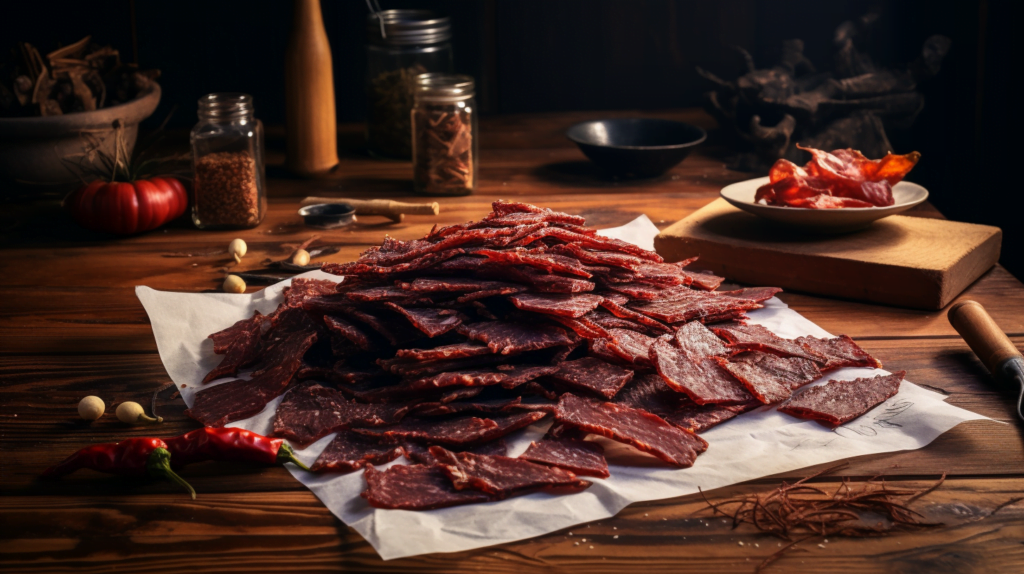
5.3 Importance of Air Circulation
In addition to maintaining the optimal temperature range, adequate air circulation is crucial for the drying process. Proper air circulation helps to remove moisture from the surface of the beef jerky, preventing the development of mold and ensuring even dehydration. Use a dehydrator with a fan or arrange the meat on wire racks to ensure that the air can circulate around each piece evenly.
6. Best Beef Jerky Temperature The Effects of Higher Drying Temperatures
While low-temperature drying is the preferred method for beef jerky making, it’s worth exploring the effects of higher drying temperatures. Drying beef jerky at higher temperatures can result in shorter drying times but may also lead to some undesirable outcomes.
6.1 Shorter Drying Time at Higher Temperatures
One advantage of using higher drying temperatures is shorter overall drying times. This can be particularly beneficial if you’re pressed for time or making beef jerky in larger quantities. However, it’s important to strike a balance between the drying time and the desired texture and flavor.
6.2 Risk of Unevenly Cooked or Tough Jerky
Drying beef jerky at higher temperatures increases the risk of uneven cooking and can result in sections of the jerky being overcooked and tough while other parts remain undercooked. Achieving a consistently tender and evenly dried texture becomes more challenging with higher temperatures. It’s important to monitor the drying process closely and adjust the temperature if necessary to ensure even cooking.
6.3 Adjusting Temperature for Personal Preferences
Ultimately, the choice of drying temperature is a matter of personal preference. Some individuals enjoy a chewier texture, while others prefer a crisper and more dehydrated jerky. By experimenting with different temperature ranges, you can find what works best for your taste preferences and desired jerky texture.
7. Best Beef Jerky Temperature Monitoring and Controlling Temperature During Drying
Achieving the perfect temperature during the drying process requires vigilance and careful monitoring. By employing proper techniques and utilizing reliable tools, you can ensure accurate temperature control and produce high-quality beef jerky.
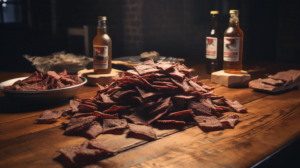
7.1 Using a Reliable Food Thermometer
A reliable food thermometer is a must-have tool when making beef jerky. It allows you to accurately measure the internal temperature of the meat, ensuring that it reaches the desired level of doneness and food safety. Use a digital thermometer with a thin probe for easy and precise temperature readings.
7.2 Placement of Thermometer for Accurate Readings
To obtain accurate temperature readings, it’s essential to place the thermometer properly. Insert the thermometer probe into the thickest part of the meat, avoiding contact with bones or fat, as these can give inaccurate readings. Ensure that the probe is inserted deep enough to reach the center of the meat.
7.3 Adjusting Heat Source for Temperature Control
Depending on the type of drying equipment you’re using, adjusting the heat source may be necessary to maintain the desired temperature. Some dehydrators come with adjustable temperature settings, allowing you to fine-tune the drying process. For other methods, such as using an oven, you may need to adjust the oven temperature periodically to maintain the desired drying temperature.
8. Best Beef Jerky Temperature Factors Affecting Temperature Fluctuations
While you strive for consistent temperature control, there are several external factors that can influence temperature fluctuations during the beef jerky making process. Being aware of these factors will help you optimize your drying setup and ensure consistent results.
8.1 Ambient Room Temperature
The ambient room temperature can have a significant impact on the drying process. Higher room temperatures can cause the drying equipment to work harder to maintain the desired drying temperature, potentially leading to overcooking or uneven drying. Consider choosing a cool and well-ventilated area for drying your beef jerky to minimize the impact of ambient temperatures.
8.2 Humidity Levels
Humidity levels play a crucial role in the drying process, affecting the overall drying time and texture of the beef jerky. Higher humidity slows down the evaporation of moisture from the meat, prolonging the drying process. Conversely, lower humidity levels facilitate faster moisture removal. Consider using a dehumidifier or a well-ventilated area to control the humidity during the drying process.
8.3 Type and Efficiency of Drying Equipment
The type and efficiency of the drying equipment you use can impact the temperature control and overall performance of the beef jerky making process. Dehydrators with adjustable temperature settings and built-in fans for proper air circulation provide greater control over the drying temperature and ensure consistent results. If using an oven, consider using an oven thermometer to monitor the temperature accuracy.
9. Best Beef Jerky Temperature Safety Precautions when Working with Temperature
Working with temperature in beef jerky making requires adherence to strict safety precautions to ensure food safety and prevent the risk of foodborne illnesses. Paying attention to proper hygiene, avoiding cross-contamination, and following storage and consumption guidelines are essential steps to take.
9.1 Proper Hygiene and Sanitization
Maintaining proper hygiene and sanitization practices is crucial throughout the beef jerky making process. Wash your hands thoroughly before handling the meat to minimize the risk of bacterial contamination. Clean and sanitize all utensils, cutting boards, and surfaces that come into contact with the meat to prevent cross-contamination.
9.2 Avoiding Cross-Contamination
Cross-contamination is a significant risk when working with raw meat. Always keep raw and cooked foods separate to prevent the transfer of bacteria. Use separate cutting boards, utensils, and containers for raw and cooked meat. Additionally, avoid using the same marinade or brine for raw and cooked beef jerky.
9.3 Storage and Consumption Guidelines
To ensure the safety and quality of your beef jerky, it’s essential to follow proper storage and consumption guidelines. Store your homemade beef jerky in airtight containers or resealable bags in a cool and dry place. Properly stored jerky can last for several months. However, it’s important to regularly check for signs of spoilage, such as mold or an off odor. Consume the beef jerky within a reasonable time frame to ensure optimal flavor and quality.
10. Best Beef Jerky Temperature Experimenting with Temperature for Unique Flavors
One of the joys of making beef jerky is the opportunity to experiment with temperature to achieve unique flavors and textures. By varying the drying temperature, you can create a wide range of flavor profiles and tailor the jerky to your personal preferences.
10.1 Infusing Flavors through Temperature Variations
Temperature variations can enhance the flavor profile of beef jerky by allowing different combinations of spices, seasonings, and marinades to shine. Higher drying temperatures can intensify the flavors, while lower temperatures can result in a milder taste. Experiment with different temperatures to discover the flavor combinations that appeal to you.
10.2 Trying Different Seasonings and Marinades
Temperature variations provide an excellent opportunity to experiment with different seasonings and marinade combinations. Higher temperatures can enhance the caramelization of sugars and result in a sweeter flavor, whereas lower temperatures may allow the flavors of herbs and spices to shine through more prominently. Don’t be afraid to get creative and explore various seasonings, such as soy sauce, ginger, garlic, or even exotic spices.
10.3 Documenting and Sharing Jerky Recipes
As you embark on your beef jerky making journey and experiment with different temperature variations, consider documenting your recipes and sharing them with others. Keeping a record of your successful experiments allows you to reproduce your favorite jerky flavors and share your creations with fellow jerky enthusiasts. Sharing your knowledge and experiences can spark inspiration and innovation within the beef jerky making community.
In conclusion, temperature control is of utmost importance in the art of making beef jerky. By understanding the role of temperature, choosing the right cuts of meat, and carefully monitoring and controlling temperature throughout the drying process, you can achieve superior results in terms of flavor, texture, and food safety. Experimenting with temperature variations allows for the creation of unique jerky flavors, while adhering to safety precautions ensures a safe and enjoyable jerky-making experience. So, grab your thermometer, select your ingredients, and start on the journey of creating delicious homemade beef jerky at the perfect temperature.